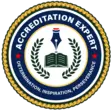Accreditation Expert Consulting employs a dual-strategy approach for the site visit component, with the first method being the execution of a site visit simulation. This entails constructing an environment that mirrors the conditions expected during an accreditation review visit. This simulated approach offers numerous benefits, which include but are not limited to:
- Familiarizing staff and faculty with the process, reducing anxiety and enhancing performance during the actual visit.
- Identifying potential non-compliance or weaknesses in current practices allow for improvements before the accrediting body’s actual evaluation.
- Enhancing the institution’s preparedness by practicing responses to potential questions and scenarios the accreditation team may pose.
- Strengthening internal communication and teamwork as staff collaborate to present a unified and coherent representation of their institution.
- Providing a valuable learning experience can lead to continuous improvement in educational quality and institutional operations beyond the accreditation process.
By engaging in this thorough preparation process, institutions are better positioned to navigate the site visit confidently, demonstrating their commitment to maintaining the high standards set forth by accrediting organizations.
The second method employed by Accreditation Expert Consulting for the site visit component involves detailed review and feedback sessions. Following the simulation, our team conducts a series of review meetings to analyze the simulation’s outcomes, identifying strengths and areas for improvement. During these sessions, we provide actionable feedback and strategies tailored to enhance the institution’s readiness for the accreditation visit. This ensures that potential issues are addressed proactively, further solidifying the institution’s preparedness for a successful accreditation outcome.
Preparing for and conducting an accreditation site visit is pivotal for institutions seeking to affirm their commitment to educational excellence and compliance with accreditation standards. The journey begins well before the visit and involves meticulous planning and engagement with the accrediting body’s protocols. Below is a structured overview from the start to the end of the site visit, encapsulating the essential steps and best practices for a successful evaluation.
Tips for Ensuring a Smooth Site Visit:
- Tidy Up Your Area: First impressions matter. Ensure your premises are clean and organized.
- Ensure Your Team is Present: Having key personnel available during the visit is crucial unless impossible.
- Carefully Consider Your Meeting Space: Ensure it is conducive to discussions and presentations.
- Offer Thoughtful Refreshments: Hospitality can set a positive tone for the day.
- Thoroughly Review Your Self-Study: Be familiar with your submission, as it will be a key reference during the visit.
The Accreditation Site Visit Overview:
The accreditation site visit is a cornerstone of the evaluation process, aimed at verifying the institution’s adherence to the accrediting body’s Standards and Criteria. The visiting team, comprised of experienced educators and specialists, will assess the institution’s quality in alignment with its mission. They will utilize the Self-Evaluation Report (Self-Study Report), documentation, interviews, and observations to form their evaluations.
Preparing for the On-Site Evaluation:
- Objective: The on-site evaluation assesses compliance with accreditation standards.
- Execution Method: Follows the accrediting body’s established procedures.
- Financial Responsibility: The institution covers the costs associated with the evaluation.
- Evaluation is essential for initial or renewal accreditation applications, substantive change evaluations, and potentially unannounced evaluations for compliance verification.
Types of Evaluations:
- Orientation Evaluations: Conducted for new applicants after the initial submission of the Self-Evaluation Report.
- Accreditation Renewal Evaluations: Planned, comprehensive evaluation by an entire team.
- Substantive Change Evaluations: Evaluations focused on reviewing significant changes.
- Directed and Unannounced Evaluations: Conducted at the accrediting body’s discretion to ensure ongoing compliance.
Evaluation Objectives and Methods:
The aim is to authenticate the institution’s submissions, which involves reviewing documentation, conducting stakeholder interviews, and assessing compliance with accreditation standards.
Evaluation Team Composition and Function:
A qualified team evaluates the institution, focusing on mission alignment, objectives, achievement, and quality assurance. The team composition includes various specialists to ensure a thorough assessment.
Notification and Handling Conflicts:
Institutions are informed about the evaluation team members in advance. To ensure fairness, any conflicts of interest or concerns regarding evaluator qualifications are addressed.
Evaluation Process and Reporting:
After the evaluation, a detailed report is prepared outlining findings on compliance and areas needing improvement. Institutions have the opportunity to respond to this report, enhancing transparency and collaboration in the accreditation process.
Provider Review Timeline:
This timeline guides institutions through the preparation phase for the quality assurance review, emphasizing key actions and deadlines. Adjustments may be made to accommodate state-specific requirements and institutional needs

